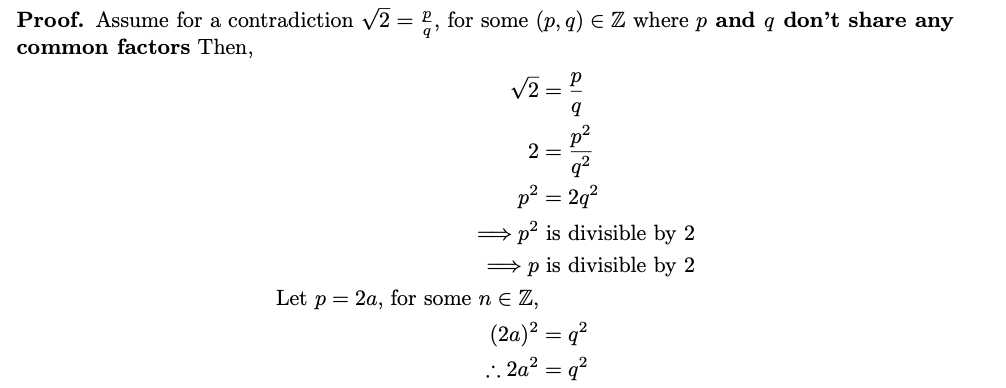- Basically a mathematical way of proving a statement
- E.g., If a is even and b is even, prove that a+b is even
- We must use notation, and definitions
| Notation | Set |
|---|---|
| Real Numbers, all rational and irrational numbers | |
| Rational numbers, all numbers that can be expressed as a fraction | |
| Integers, all whole numbers | |
| All natural numbers, i.e. all positive integers. Does not include 0 |
- If n is even, write:
- Let
- If n is odd, write:
- Let
- If n is rational, write:
- Let
- If n is divisible by d for some integer d, write:
- Let
- ALWAYS INCLUDE THE SET IT IS IN, E.G.
- THIS IS VERY IMPORTANT, YOU WILL LOSE MARKS IF YOU DO NOT DEFINE THE SET
- NEVER ASSUME WHAT YOU WANT TO PROVE. THIS IS A FALSE PROOF, AND WILL COST YOU MARKS
- ALWAYS WRITE “QED” AT THE END OF EVERY PROOF
- This is Latin for “thus it has been proven”, and shows that you have completed your proof
Some Definitions on Proof
Given a true conditional statement, If A then B:
- The converse may or may not be true: If B then A
- The inverse may or may not be true: If not A then not B
- The contrapositive is always true: If not B, then not A
Direct Proofs
- A proof that is very logical
- You are given an assumption, and asked to prove something
- “If A, then B”
- Assume that A is true
- Show that B must follow as a consequence
Proof by Contraposition, or Contrapositive Proofs
- The contrapositive of a true conditional statement (If A then B) is always true
- Contrapositive is: If not B, then not A
- Contrapositive of “A and B” is “not A or not B”
- Contrapositive of “A or B” is “not A and not B”
- Write as “If not B then not A”
- Assume that “not B” is true
- Show that “not A” must follow as a consequence
- Since it is a contrapositive statement, then “If A then B” is also true
Equivalence Proofs
- A proof that has “if and only if” in the statement
- “A if and only if B”
- Saying that “If A, then B” and “If B, then A”
- Show that if A is true, B must follow as a consequence
- Show that if B is true, A must follow as a consequence
Proof by Contradiction
- Basically a false proof
- We try to prove the opposite of what we are told to prove
- For example, if we are trying to prove “If A then B”, we try to prove “If A then not B”
- We show that this is false, or cannot make sense, and that “If A then B” is actually true, as our proof is incorrect
- We usually do this by assuming that a number is irrational, then showing that it is rational
- Write as “If A then not B”
- Assume that this is true, that “If A then B” is false
- Show that this leads to an impossible conclusion
- “The negation of this conjecture is incorrect as it contradicts…”
- Then the conjecture must be true


Recurring Decimals as Fractions
- Sometimes, you’ll be asked to represent recurring decimals as fractions
- When that happens, define the decimal as x
- Multiply the decimal by a multiple of 10, until it has a digit that is repeated, in its tens and ones digit. We’ll call this multiple k
- Multiply the decimal by a multiple of 10, until it only has recurring decimals
- Take mx from kx, and this will eliminate the recurring decimals. We’ll call this y
- This can be represented as (k-m)x = y